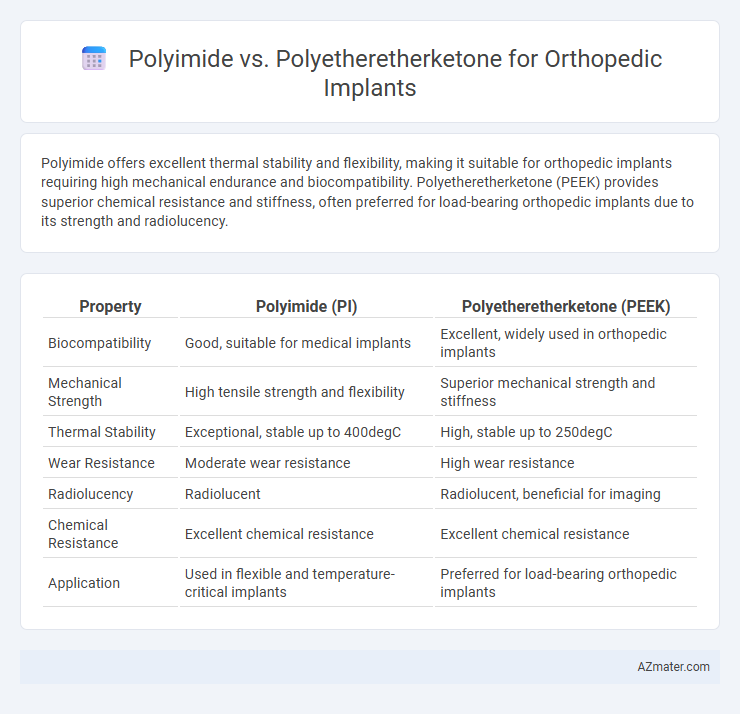Polyimide offers excellent thermal stability and flexibility, making it suitable for orthopedic implants requiring high mechanical endurance and biocompatibility. Polyetheretherketone (PEEK) provides superior chemical resistance and stiffness, often preferred for load-bearing orthopedic implants due to its strength and radiolucency.
Table of Comparison
| Property | Polyimide (PI) | Polyetheretherketone (PEEK) |
|---|---|---|
| Biocompatibility | Good, suitable for medical implants | Excellent, widely used in orthopedic implants |
| Mechanical Strength | High tensile strength and flexibility | Superior mechanical strength and stiffness |
| Thermal Stability | Exceptional, stable up to 400degC | High, stable up to 250degC |
| Wear Resistance | Moderate wear resistance | High wear resistance |
| Radiolucency | Radiolucent | Radiolucent, beneficial for imaging |
| Chemical Resistance | Excellent chemical resistance | Excellent chemical resistance |
| Application | Used in flexible and temperature-critical implants | Preferred for load-bearing orthopedic implants |
Introduction to Polyimide and Polyetheretherketone (PEEK)
Polyimide is a high-performance polymer known for its excellent thermal stability, mechanical strength, and chemical resistance, making it suitable for demanding orthopedic implant applications requiring durability and biocompatibility. Polyetheretherketone (PEEK) is a semicrystalline thermoplastic with superior mechanical properties, radiolucency, and bioinertness, widely used in spinal, joint, and trauma implants for its ability to withstand physiological loads. Both polymers offer advantageous characteristics for orthopedic implants, with PEEK favored for load-bearing roles and polyimide valued for its flexibility and thermal resistance.
Material Composition and Structure Comparison
Polyimide exhibits an aromatic imide backbone with alternating carbonyl groups, providing exceptional thermal stability and chemical resistance suitable for orthopedic implants. Polyetheretherketone (PEEK) features a semi-crystalline structure composed of repeating ether and ketone groups, offering high mechanical strength and biocompatibility in load-bearing applications. The molecular rigidity of polyimide contrasts with PEEK's balanced crystallinity and flexibility, influencing their respective wear resistance and integration properties within the human body.
Mechanical Properties in Orthopedic Applications
Polyetheretherketone (PEEK) exhibits superior mechanical properties compared to polyimide for orthopedic implants, including higher tensile strength, greater fatigue resistance, and enhanced stiffness, which are critical for load-bearing applications. PEEK's modulus of elasticity closely matches that of cortical bone, reducing stress shielding and promoting better bone integration, whereas polyimide's lower mechanical strength limits its use primarily to flexible or supportive roles. The biocompatibility and wear resistance of PEEK further contribute to its preference in long-term orthopedic implant applications.
Biocompatibility and Biological Response
Polyetheretherketone (PEEK) exhibits superior biocompatibility compared to polyimide, demonstrating minimal inflammatory response and excellent osseointegration in orthopedic implants. PEEK's chemical stability and inert surface properties reduce cytotoxicity and support favorable cellular adhesion, promoting long-term implant success. Polyimide, although biocompatible, may elicit a higher foreign body reaction, limiting its widespread application in load-bearing orthopedic devices.
Wear Resistance and Longevity in Implants
Polyetheretherketone (PEEK) exhibits superior wear resistance and longevity compared to polyimide, making it a preferred material for orthopedic implants subjected to repetitive mechanical stress. The high abrasion resistance and chemical stability of PEEK significantly reduce particle generation and implant degradation over time, enhancing biocompatibility and implant lifespan. Polyimide, while flexible and lightweight, generally shows higher wear rates and lower durability under physiological load-bearing conditions, limiting its long-term implant applications.
Imaging Compatibility: MRI and Radiolucency
Polyetheretherketone (PEEK) offers superior MRI compatibility and radiolucency compared to polyimide, making it the preferred material for orthopedic implants requiring clear postoperative imaging. PEEK demonstrates minimal artifact production in MRI scans, allowing for precise visualization of surrounding tissues and implant integration without signal distortion. In contrast, polyimide's denser structure often causes imaging artifacts, compromising diagnostic accuracy and limiting its effectiveness in applications where radiolucency is critical.
Sterilization and Chemical Stability
Polyimide and Polyetheretherketone (PEEK) exhibit distinct advantages in orthopedic implant sterilization and chemical stability. Polyimide offers excellent thermal resistance, enabling autoclave sterilization without degradation, while PEEK maintains chemical inertness and structural integrity under various sterilization methods including gamma irradiation and ethylene oxide. PEEK's superior chemical stability and biocompatibility make it a preferred choice for long-term implant applications despite polyimide's robust heat resistance.
Manufacturing and Processing Techniques
Polyimide offers excellent thermal stability and chemical resistance, enabling precision manufacturing through techniques like injection molding, spin coating, and laser machining, which are crucial for intricate orthopedic implant designs. Polyetheretherketone (PEEK) is favored for its high mechanical strength and biocompatibility, processed primarily by injection molding, extrusion, and CNC machining, allowing for robust and customizable implant fabrication. Both materials require specialized equipment for processing at elevated temperatures, but PEEK's superior wear resistance often leads to longer implant life in orthopedic applications.
Clinical Applications and Case Studies
Polyetheretherketone (PEEK) is widely favored in orthopedic implants due to its superior biocompatibility, radiolucency, and mechanical strength that closely matches human cortical bone, as demonstrated in numerous clinical case studies for spinal fusion and joint replacement. Polyimide, while offering excellent thermal stability and flexibility, has limited clinical application in orthopedics because of its lower mechanical durability and bioinertness, making it more suitable for non-load-bearing uses such as neural interfaces. Comparative studies highlight PEEK's efficacy in reducing implant-related complications and promoting osteointegration, establishing it as the preferred polymer in load-bearing orthopedic device manufacturing.
Cost Considerations and Future Prospects
Polyimide offers a lower upfront cost compared to Polyetheretherketone (PEEK), making it an attractive option for budget-sensitive orthopedic implants despite its relatively lower mechanical strength and biocompatibility. PEEK, while more expensive, provides superior durability, chemical resistance, and excellent osseointegration properties, contributing to enhanced long-term implant performance and patient outcomes. Future prospects emphasize developing cost-effective PEEK composites and advanced polyimide formulations to balance affordability with biomechanical and biological efficacy in orthopedic applications.

Infographic: Polyimide vs Polyetheretherketone for Orthopedic Implant
 azmater.com
azmater.com